Sanghyun Jo
ISAC: Training-Free Instance-to-Semantic Attention Control for Improving Multi-Instance Generation
May 27, 2025Abstract:Text-to-image diffusion models excel at generating single-instance scenes but struggle with multi-instance scenarios, often merging or omitting objects. Unlike previous training-free approaches that rely solely on semantic-level guidance without addressing instance individuation, our training-free method, Instance-to-Semantic Attention Control (ISAC), explicitly resolves incomplete instance formation and semantic entanglement through an instance-first modeling approach. This enables ISAC to effectively leverage a hierarchical, tree-structured prompt mechanism, disentangling multiple object instances and individually aligning them with their corresponding semantic labels. Without employing any external models, ISAC achieves up to 52% average multi-class accuracy and 83% average multi-instance accuracy by effectively forming disentangled instances. The code will be made available upon publication.
Early Timestep Zero-Shot Candidate Selection for Instruction-Guided Image Editing
Apr 18, 2025Abstract:Despite recent advances in diffusion models, achieving reliable image generation and editing remains challenging due to the inherent diversity induced by stochastic noise in the sampling process. Instruction-guided image editing with diffusion models offers user-friendly capabilities, yet editing failures, such as background distortion, frequently occur. Users often resort to trial and error, adjusting seeds or prompts to achieve satisfactory results, which is inefficient. While seed selection methods exist for Text-to-Image (T2I) generation, they depend on external verifiers, limiting applicability, and evaluating multiple seeds increases computational complexity. To address this, we first establish a multiple-seed-based image editing baseline using background consistency scores, achieving Best-of-N performance without supervision. Building on this, we introduce ELECT (Early-timestep Latent Evaluation for Candidate Selection), a zero-shot framework that selects reliable seeds by estimating background mismatches at early diffusion timesteps, identifying the seed that retains the background while modifying only the foreground. ELECT ranks seed candidates by a background inconsistency score, filtering unsuitable samples early based on background consistency while preserving editability. Beyond standalone seed selection, ELECT integrates into instruction-guided editing pipelines and extends to Multimodal Large-Language Models (MLLMs) for joint seed and prompt selection, further improving results when seed selection alone is insufficient. Experiments show that ELECT reduces computational costs (by 41 percent on average and up to 61 percent) while improving background consistency and instruction adherence, achieving around 40 percent success rates in previously failed cases - without any external supervision or training.
COIN: Confidence Score-Guided Distillation for Annotation-Free Cell Segmentation
Mar 17, 2025



Abstract:Cell instance segmentation (CIS) is crucial for identifying individual cell morphologies in histopathological images, providing valuable insights for biological and medical research. While unsupervised CIS (UCIS) models aim to reduce the heavy reliance on labor-intensive image annotations, they fail to accurately capture cell boundaries, causing missed detections and poor performance. Recognizing the absence of error-free instances as a key limitation, we present COIN (COnfidence score-guided INstance distillation), a novel annotation-free framework with three key steps: (1) Increasing the sensitivity for the presence of error-free instances via unsupervised semantic segmentation with optimal transport, leveraging its ability to discriminate spatially minor instances, (2) Instance-level confidence scoring to measure the consistency between model prediction and refined mask and identify highly confident instances, offering an alternative to ground truth annotations, and (3) Progressive expansion of confidence with recursive self-distillation. Extensive experiments across six datasets show COIN outperforming existing UCIS methods, even surpassing semi- and weakly-supervised approaches across all metrics on the MoNuSeg and TNBC datasets. The code is available at https://github.com/shjo-april/COIN.
DiffEGG: Diffusion-Driven Edge Generation as a Pixel-Annotation-Free Alternative for Instance Annotation
Mar 11, 2025



Abstract:Achieving precise panoptic segmentation relies on pixel-wise instance annotations, but obtaining such datasets is costly. Unsupervised instance segmentation (UIS) eliminates annotation requirements but struggles with adjacent instance merging and single-instance fragmentation, largely due to the limitations of DINO-based backbones which lack strong instance separation cues. Weakly-supervised panoptic segmentation (WPS) reduces annotation costs using sparse labels (e.g., points, boxes), yet these annotations remain expensive and introduce human bias and boundary errors. To address these challenges, we propose DiffEGG (Diffusion-Driven EdGe Generation), a fully annotation-free method that extracts instance-aware features from pretrained diffusion models to generate precise instance edge maps. Unlike DINO-based UIS methods, diffusion models inherently capture fine-grained, instance-aware features, enabling more precise boundary delineation. For WPS, DiffEGG eliminates annotation costs and human bias by operating without any form of manual supervision, addressing the key limitations of prior best methods. Additionally, we introduce RIP, a post-processing technique that fuses DiffEGG's edge maps with segmentation masks in a task-agnostic manner. RIP allows DiffEGG to be seamlessly integrated into various segmentation frameworks. When applied to UIS, DiffEGG and RIP achieve an average $+4.4\text{ AP}$ improvement over prior best UIS methods. When combined with weakly-supervised semantic segmentation (WSS), DiffEGG enables WPS without instance annotations, outperforming prior best point-supervised WPS methods by $+1.7\text{ PQ}$. These results demonstrate that DiffEGG's edge maps serve as a cost-effective, annotation-free alternative to instance annotations, significantly improving segmentation without human intervention. Code is available at https://github.com/shjo-april/DiffEGG.
TTD: Text-Tag Self-Distillation Enhancing Image-Text Alignment in CLIP to Alleviate Single Tag Bias
Mar 30, 2024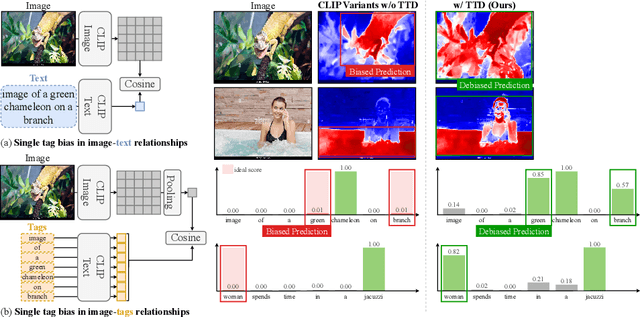


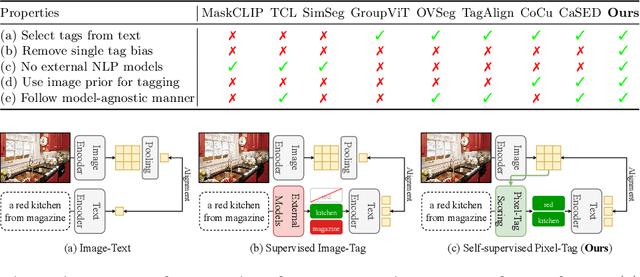
Abstract:We identify a critical bias in contemporary CLIP-based models, which we denote as \textit{single tag bias}. This bias manifests as a disproportionate focus on a singular tag (word) while neglecting other pertinent tags, stemming from CLIP's text embeddings that prioritize one specific tag in image-text relationships. When deconstructing text into individual tags, only one tag tends to have high relevancy with CLIP's image embedding, leading to an imbalanced tag relevancy. This results in an uneven alignment among multiple tags present in the text. To tackle this challenge, we introduce a novel two-step fine-tuning approach. First, our method leverages the similarity between tags and their nearest pixels for scoring, enabling the extraction of image-relevant tags from the text. Second, we present a self-distillation strategy aimed at aligning the combined masks from extracted tags with the text-derived mask. This approach mitigates the single tag bias, thereby significantly improving the alignment of CLIP's model without necessitating additional data or supervision. Our technique demonstrates model-agnostic improvements in multi-tag classification and segmentation tasks, surpassing competing methods that rely on external resources. Code is available at https://github.com/shjo-april/TTD.
DHR: Dual Features-Driven Hierarchical Rebalancing in Inter- and Intra-Class Regions for Weakly-Supervised Semantic Segmentation
Mar 30, 2024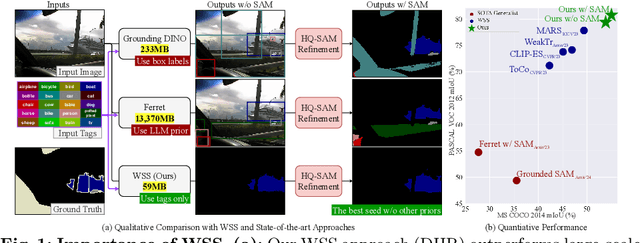

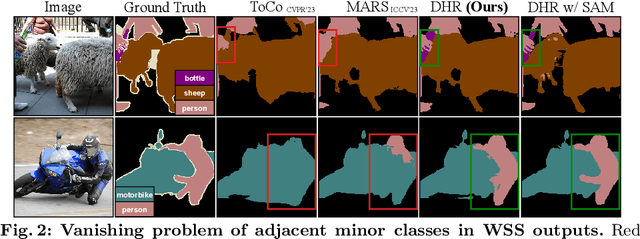
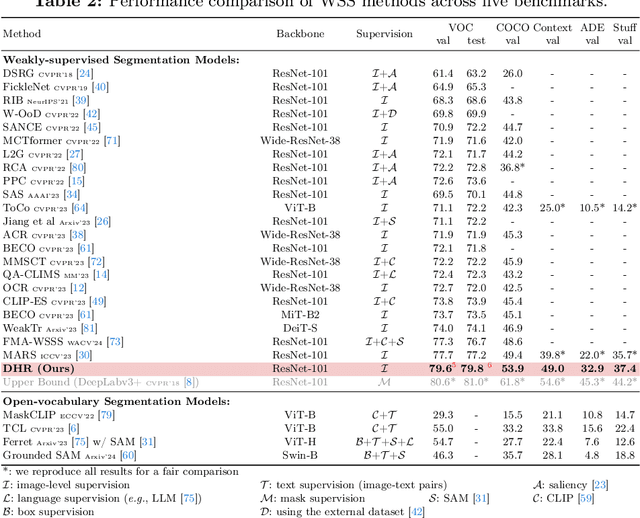
Abstract:Weakly-supervised semantic segmentation (WSS) ensures high-quality segmentation with limited data and excels when employed as input seed masks for large-scale vision models such as Segment Anything. However, WSS faces challenges related to minor classes since those are overlooked in images with adjacent multiple classes, a limitation originating from the overfitting of traditional expansion methods like Random Walk. We first address this by employing unsupervised and weakly-supervised feature maps instead of conventional methodologies, allowing for hierarchical mask enhancement. This method distinctly categorizes higher-level classes and subsequently separates their associated lower-level classes, ensuring all classes are correctly restored in the mask without losing minor ones. Our approach, validated through extensive experimentation, significantly improves WSS across five benchmarks (VOC: 79.8\%, COCO: 53.9\%, Context: 49.0\%, ADE: 32.9\%, Stuff: 37.4\%), reducing the gap with fully supervised methods by over 84\% on the VOC validation set. Code is available at https://github.com/shjo-april/DHR.
MARS: Model-agnostic Biased Object Removal without Additional Supervision for Weakly-Supervised Semantic Segmentation
Apr 19, 2023Abstract:Weakly-supervised semantic segmentation aims to reduce labeling costs by training semantic segmentation models using weak supervision, such as image-level class labels. However, most approaches struggle to produce accurate localization maps and suffer from false predictions in class-related backgrounds (i.e., biased objects), such as detecting a railroad with the train class. Recent methods that remove biased objects require additional supervision for manually identifying biased objects for each problematic class and collecting their datasets by reviewing predictions, limiting their applicability to the real-world dataset with multiple labels and complex relationships for biasing. Following the first observation that biased features can be separated and eliminated by matching biased objects with backgrounds in the same dataset, we propose a fully-automatic/model-agnostic biased removal framework called MARS (Model-Agnostic biased object Removal without additional Supervision), which utilizes semantically consistent features of an unsupervised technique to eliminate biased objects in pseudo labels. Surprisingly, we show that MARS achieves new state-of-the-art results on two popular benchmarks, PASCAL VOC 2012 (val: 77.7%, test: 77.2%) and MS COCO 2014 (val: 49.4%), by consistently improving the performance of various WSSS models by at least 30% without additional supervision.
Puzzle-CAM: Improved localization via matching partial and full features
Feb 02, 2021



Abstract:Weakly-supervised semantic segmentation (WSSS) is introduced to narrow the gap for semantic segmentation performance from pixel-level supervision to image-level supervision. Most advanced approaches are based on class activation maps (CAMs) to generate pseudo-labels to train the segmentation network. The main limitation of WSSS is that the process of generating pseudo-labels from CAMs that use an image classifier is mainly focused on the most discriminative parts of the objects. To address this issue, we propose Puzzle-CAM, a process that minimizes differences between the features from separate patches and the whole image. Our method consists of a puzzle module and two regularization terms to discover the most integrated region in an object. Puzzle-CAM can activate the overall region of an object using image-level supervision without requiring extra parameters. % In experiments, Puzzle-CAM outperformed previous state-of-the-art methods using the same labels for supervision on the PASCAL VOC 2012 test dataset. In experiments, Puzzle-CAM outperformed previous state-of-the-art methods using the same labels for supervision on the PASCAL VOC 2012 dataset. Code associated with our experiments is available at https://github.com/OFRIN/PuzzleCAM.
 Add to Chrome
Add to Chrome Add to Firefox
Add to Firefox Add to Edge
Add to Edge